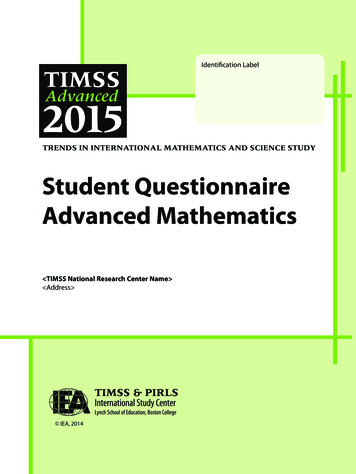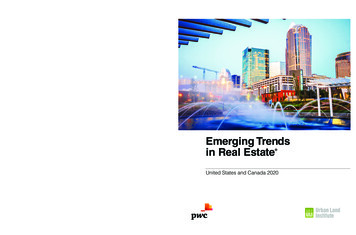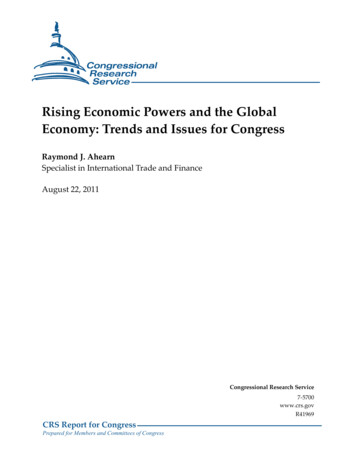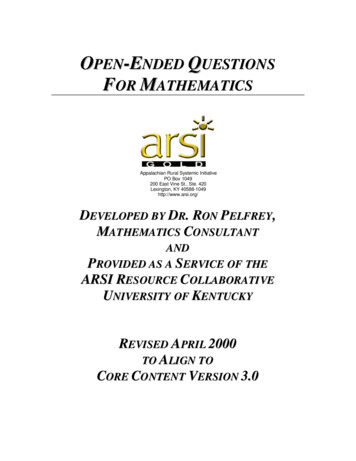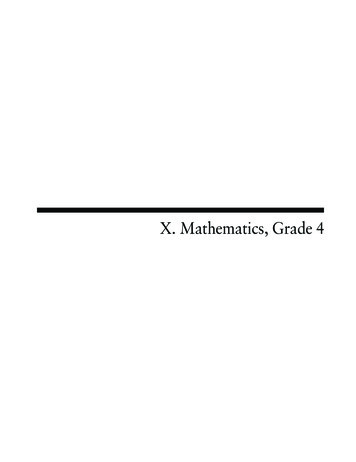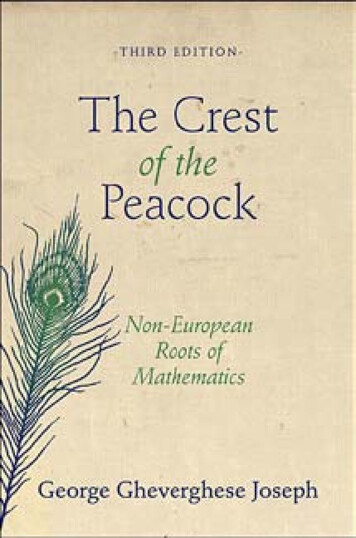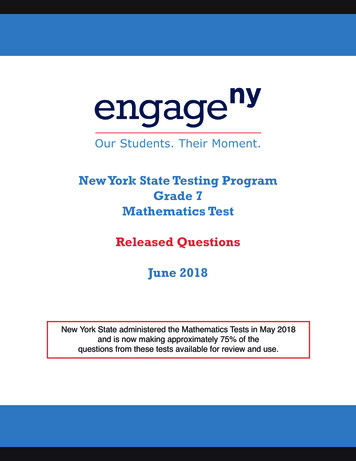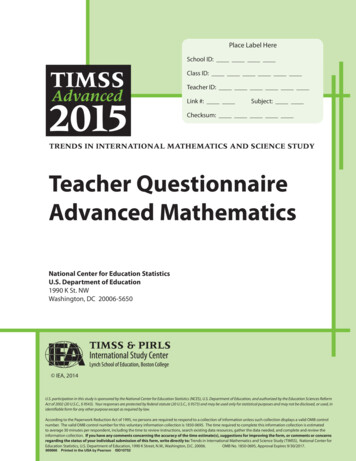
Transcription
Place Label HereSchool ID:Identification LabelClass ID:Teacher ID:Link #:Subject:Checksum:TRENDS IN INTERNATIONAL MATHEMATICS AND SCIENCE STUDYTeacher QuestionnaireAdvanced MathematicsNational Center for Education StatisticsU.S. Department of Education1990 K St. NWWashington, DC 20006-5650 IEA, 2014U.S. participation in this study is sponsored by the National Center for Education Statistics (NCES), U.S. Department of Education, and authorized by the Education Sciences ReformAct of 2002 (20 U.S.C., § 9543). Your responses are protected by federal statute (20 U.S.C., § 9573) and may be used only for statistical purposes and may not be disclosed, or used, inidentifiable form for any other purpose except as required by law.According to the Paperwork Reduction Act of 1995, no persons are required to respond to a collection of information unless such collection displays a valid OMB controlnumber. The valid OMB control number for this voluntary information collection is 1850-0695. The time required to complete this information collection is estimatedto average 30 minutes per respondent, including the time to review instructions, search existing data resources, gather the data needed, and complete and review theinformation collection. If you have any comments concerning the accuracy of the time estimate(s), suggestions for improving the form, or comments or concernsregarding the status of your individual submission of this form, write directly to: Trends in International Mathematics and Science Study (TIMSS), National Center forEducation Statistics, U.S. Department of Education, 1990 K Street, N.W., Washington, D.C. 20006.OMB No. 1850-0695, Approval Expires 9/30/2017.869866Printed in the USA by PearsonISD10752
Teacher Questionnaire—Advanced MathematicsWhen you have completed the questionnaire,Your school has agreed to participate inTIMSS Advanced 2015 (Trends in Internationalplease place it in the accompanying envelope andMathematics and Science Study), an educationalreturn it to the TIMSS school coordinator.NCES is authorized to collect information fromresearch project sponsored by the InternationalAssociation for the Evaluation of Educationalthe questionnaire under the Education ScienceAchievement (IEA). TIMSS Advanced measures trendsReform Act of 2002 (ESRA 2002), 20 U.S. Code, §in student achievement in advanced mathematics and9543. You do not have to provide the informationphysics and studies differences in national educationrequested. However, the information you providesystems in order to help improve teaching and learningwill help the U.S. Department of Education’sworldwide.ongoing efforts to understand better how theThis questionnaire is addressed to teachers ofeducational system in the United States comparestwelfth-grade students who have taken or are takingto that in other countries. There are no penaltiesa calculus course. It seeks information about teachers’should you choose not to participate in this study.academic and professional backgrounds, classroomYour answers may be used only for statisticalresources, instructional practices, and attitudes towardpurposes and may not be disclosed, or used, inteaching. Since your class has been selected as part of aidentifiable form for any other purpose exceptnationwide sample, your responses are very importantas required by law (20 U.S. Code, § 9573). Yourin helping to describe the school system in the Unitedresponse will be combined with those from otherStates.participants to produce summary statistics andSome of the questions in the questionnaire refer toreports.the “TIMSS class” or “this class.” This is the class thatThis survey is estimated to take an averageis identified on the front of this booklet and that willof 30 minutes, including time for reviewingbe tested as part of TIMSS Advanced in your school. Itinstructions, and completing and reviewing theis important that you answer each question carefullycollection of information. An agency may notso that the information that you provide reflects yourconduct or sponsor, and a person is not requiredsituation as accurately as possible.to respond to, a collection of information unlessSince TIMSS Advanced is an international study andit displays a currently valid OMB control number.all countries are using the same questionnaire, youSend comments regarding this burden estimate ormay find that some of the questions seem unusual orany other aspect of this collection of information,are not entirely relevant to you or schools in the Unitedincluding suggestions for reducing burden, to:States. Nevertheless, it is important that you do yourStephen Provasnik, National Center for Educationbest to answer all of the questions so comparisons canStatistics, U.S. Department of Education, 1990 Kbe made across countries in the studies.Street NW, Room 8123, Washington, DC 20006-It is estimated that you will need approximately 30minutes to complete this questionnaire. We appreciate5650. Do not return the completed form to thisaddress.the time and effort that this takes and thank you foryour cooperation and contribution.Thank you.TIMSS ADVANCED 20152Teacher Questionnaire — Advanced Mathematics
About You14A. What year did you start teaching?What is the highest level of formal education youhave completed?Please write in a year.Fill in one circle only.Did not complete a college degree ---1(If you have not completeda college degree, go toquestion 6)B. At the end of this school year, how many yearswill you have taught altogether?yearsPlease round to the nearest whole number.Associate’s degree(2-year college program) ---2Bachelor’s degree(4-year college program) ---3Master’s degree or professional degree(MD, DDS, lawyer, minister) ---4Doctorate (Ph.D., or Ed.D.) --- 52Are you female or male?Fill in one circle only.1Male --- 2Female ---5During your college or university education, whatwas your major or main area(s) of study?Fill in only one circle for each row.3YesNoHow old are you?Fill in one circle only.125–29 --- 230–39 --- 340–49 --- 450–59 --- 560 or more --- 6Under 25 ---1b) Physics ------------------------------------------- 1c) Biology ------------------------------------------- 1d) Chemistry ---------------------------------------- 1e) Earth Science ------------------------------------ 1f) Engineering -------------------------------------- 1g) Education– Mathematics ------------------------ 1h) Education– Physics ------------------------------ 1i) Education– Science ------------------------------ 1j) Education– General ------------------------------ 1k) Other --------------------------------------------- 1a) Mathematics -------------------------------------Teacher Questionnaire — Advanced Mathematics222222222223
School Emphasis on AdvancedMathematics and Physics EducationSchool Environment76How much do you agree with these statementsabout advanced mathematics and physics educationwithin your school?Fill in only one circle for each row.Thinking about your current school, indicate theextent to which you agree or disagree with each ofthe following statements.Fill in only one circle for each row.Agree a lotAgree a lotAgree a littleAgree a littleDisagree a littleDisagree a littleDisagreea lotDisagreea lota) The school encourages studentsto study advanced mathematicsand physics -------------------- 1b) The school promotesprofessional development forteachers of advancedmathematics and physics ----- 1c) The school provides studentswith information about careeroptions in advancedmathematics and physics ----- 1d) Advanced mathematics andphysics teachers are admired byother teachers in the school --- 142 3 42 3 42 3 42 3 4e) Teachers have high expectationsfor student achievement inadvanced mathematics andphysics ------------------------- 12 3 4f) Students at this school respectstudents who excel in advancedmathematics and physics ----- 12 3 4g) Parents expect their children tostudy advanced mathematicsand physics -------------------- 12 3 4Teacher Questionnaire — Advanced Mathematicsa) This school is located ina safe neighborhood ---------- 12 3 4b) I feel safe at this school -------- 1 2 3 4c) This school’s security policiesand practices are sufficient ---- 12 3 4d) The students behave in anorderly manner ---------------- 12 3 4e ) The students are respectfulof the teachers ----------------- 12 3 4f ) The students respectschool property ---------------- 12 3 4g) This school has clear rulesabout student conduct -------- 12 3 4h) This school's rules areenforced in a fair andconsistent manner ------------- 12 3 4
About Being a Teacher98In your current school, how severe is each problem?Fill in only one circle for each row.How often do you have the following types ofinteractions with other teachers?Fill in only one circle for each row.Not a problemVery oftenMinor problemOftenModerate problemSometimesSeriousproblema) The school building needssignificant repair -------------- 12 3 4Never oralmostnevera) Discuss how to teacha particular topic -------------- 12 3 42 3 4c) Teachers do not haveadequate instructionalmaterials and supplies -------- 1b) Collaborate in planningand preparing instructionalmaterials ----------------------- 12 3 42 3 4d) The school classrooms are notcleaned often enough --------- 1c) Share what I havelearned about myteaching experiences ---------- 12 3 42 3 4e) The school classrooms needmaintenance work ------------- 1d) Visit another classroom tolearn more about teaching ---- 12 3 42 3 4f) Teachers do not have adequatetechnological resources -------- 1e) Work together totry out new ideas -------------- 12 3 42 3 4f) Work as a group onimplementing thecurriculum --------------------- 12 3 4g) Work with teachers fromother grades to ensurecontinuity in learning --------- 12 3 4b) Teachers do not haveadequate workspace (e.g., forpreparation, collaboration,or meeting with students) ---- 1g) Teachers do not have adequatesupport for usingtechnology --------------------- 12 3 4Teacher Questionnaire — Advanced Mathematics5
1011How often do you feel the following wayabout being a teacher?Indicate the extent to which you agree or disagreewith each of the following statements.Fill in only one circle for each row.Very oftenFill in only one circle for each row.Agree a lotOftenAgree a littleSometimesNever oralmostnevera) I am content with myprofession as a teacher -------- 1b) I am satisfied with beinga teacher at this school -------- 1c) I find my work full ofmeaning and purpose --------- 12 3 42 3 42 3 4d) I am enthusiasticabout my job ------------------ 12 3 4e) My work inspires me ----------- 1 2 3 4f) I am proud of the work I do --- 1 2 3 4g) I am going to continueteaching for as long as I can --- 162 3 4Teacher Questionnaire — Advanced MathematicsDisagree a littleDisagreea lota) There are too manystudents in the classes --------- 12 3 4b) I have too much material tocover in class ------------------- 12 3 4c) I have too many teachinghours --------------------------- 12 3 4d) I need more time to preparefor class ------------------------ 12 3 4e) I need more time to assistindividual students ------------ 12 3 4f) I feel too much pressurefrom parents ------------------- 12 3 4g) I have difficulty keeping upwith all of the changes to thecurriculum --------------------- 12 3 4h) I have too many administrativetasks --------------------------- 12 3 4
About Teaching the TIMSS ClassIf you teach more than one advanced mathematics orphysics class, select one of your classes and keep it inmind as you answer questions 12 through 15.15In your view, to what extent do the following limithow you teach this class?Fill in only one circle for each row.12Not at allHow many students are in this class?SomeA lotstudentsWrite in the number.13How many students in this class experiencedifficulties understanding spoken English?students in this classWrite in the number.14a) Students lacking prerequisitemathematics knowledgeor skills ------------------------- 12 3b) Students suffering fromlack of basic nutrition --------- 12 3c) Students suffering fromnot enough sleep -------------- 12 3d) Students with physicaldisabilities --------------------- 12 3e) Students with mental,emotional, or psychologicaldisabilities --------------------- 12 3How often do you do the following in teaching thisclass?Fill in only one circle for each row.Every or almost every lessonAbout half the lessonsSome lessonsNevera) Relate the lesson to students’daily lives ---------------------- 12 3 4b) Ask students to explain theiranswers ------------------------ 12 3 4c) Ask students to completechallenging exercises thatrequire them to go beyondthe instruction ----------------- 12 3 4d) Encourage classroomdiscussions among students -- 12 3 4e) Link new content tostudents’ prior knowledge ---- 12 3 4f) Ask students to decide theirown problem solvingprocedures --------------------- 12 3 4g) Encourage students to expresstheir ideas in class ------------- 12 3 4Teacher Questionnaire — Advanced Mathematics7
Teaching Advanced Mathematics to the TIMSS ClassIf you teach more than one advanced mathematicsclass, select one of your classes and keep it in mindas you answer questions 16 through 19.1816In a typical week, how much time do you spendteaching advanced mathematics to the students inthis class?minutes per weekWrite in the number of minutes per week.Please convert the number of instructional hours or periodsinto minutes.17How many minutes per week do you usually spendpreparing to teach this class?minutes per weekWrite in the number of minutes per week.Please convert the number of hours into minutes.8Teacher Questionnaire — Advanced MathematicsIn teaching advanced mathematics to this class,how would you characterize your confidence indoing the following?Fill in only one circle for each row.Very highHighMediumLowa) Inspiring students to learnadvanced mathematics ------- 12 3 4b) Showing students a variety ofproblem solving strategies ---- 12 3 4c) Providing challenging tasksfor the highest achievingstudents ----------------------- 12 3 4d) Adapting my teaching toengage students’ interest ----- 12 3 4e) Helping students appreciatethe value of learningadvanced mathematics ------- 12 3 4f) Assessing studentcomprehension of advancedmathematics ------------------- 12 3 4g) Improving the understandingof struggling students --------- 12 3 4h) Making advanced mathematicsrelevant to students ----------- 12 3 4i) Developing students’higher-order thinking skills --- 12 3 4
Technology for TeachingMathematics to the TIMSS Class19Question 20 asks about technology for teachingmathematics to the students in the TIMSSclass. If you teach more than one advancedmathematics class, select one of your classesand keep it in mind as you answer question 20.In teaching advanced mathematics to this class, howoften do you ask students to do the following?Fill in only one circle for each row.Every or almost every lessonAbout half the lessonsSome lessonsNevera) Listen to me explainnew mathematics content ---- 12 3 4b) Listen to me explain how tosolve problems ---------------- 12 3 4c) Memorize rules, formulas,procedures, and facts ---------- 12 3 4d) Work problems (individuallyor with peers) with myguidance ----------------------- 1e) Work problems together inthe whole class with directguidance from me ------------- 1f) Work problems (individuallyor with peers) while I amoccupied by other tasks ------- 1g) Solve problems like theexamples in their textbooks -- 1h) Discuss problem solvingstrategies ---------------------- 1i) Work on problems for whichthere is no immediatelyobvious method of solution --- 1j) Communicate theirarguments --------------------- 120A. Do the students in this class have computers,tablets, calculators, or smartphones available touse during their advanced mathematics lessons?Fill in one circle only.1No -- 2Yes --(If No, go to question 21)If Yes,2 3 42 3 4B. How often do you have the students dothe following activities on computers, tablets,calculators, or smartphones during advancedmathematics lessons?Fill in only one circle for each row.2 3 4Every or almost every dayOnce or twice a weekOnce or twice amonth2 3 4Never oralmostnever2 3 42 3 42 3 4k) Take a written test or quiz ----- 1 2 3 4a) Read the textbook orcourse materials indigital format ------------------ 1b) Look up ideas andinformation -------------------- 12 3 42c) Process and analyze data ------ 1 2d) Draw graphs of functions ------ 1 2e) Solve equations ---------------- 1 233334444f) Manipulate algebraicexpressions -------------------- 12 3 4g) Conduct modeling andsimulations -------------------- 12 3 4h) Perform numericalintegration --------------------- 12 3 4Teacher Questionnaire — Advanced Mathematics9
Advanced Mathematics Topics Taught to the TIMSS Class21Question 21 asks about the topics taught and the content covered in teaching advanced mathematics to thestudents in the TIMSS class. If you teach more than one advanced mathematics class, select one of your classesand keep it in mind as you answer question 21.The following list includes the main topics addressed by the TIMSS Advanced mathematics test. Choose theresponse that best describes when the students in this class have been taught each topic. If a topic was in thecurriculum before this year, please choose “Mostly taught before this year.” If a topic was taught half this year butnot yet completed, please choose “Mostly taught this year.” If a topic is not in the curriculum, please choose “Notyet taught or just introduced.”Fill in only one circle for each row.Mostly taught before this yearMostly taught this yearNot yet taught orjust introducedA. Algebraa) Operations with exponential, logarithmic, polynomial, rational, and radical expressions---------------------------------- 12b) Operations with complex numbers ----------------------------------------- 1 2c) Evaluating algebraic expressions (e.g., exponential, logarithmic, polynomial, rational, and radical) ---------------------- 1 2d) The nth term of arithmetic and geometric sequences and the sums of finite and infinite series --------------------------- 1 23333e) Linear, simultaneous, and quadratic equations and inequalities; radical equations,logarithmic, and exponential equations ----------------------------------- 12 3f) Slopes, y-axis intercepts, and points of intersection of straight lines ----- 1 2 3g Equivalent representations of functions, including composite functions, as ordered pairs, tables, graphs,formulas, or words -------- 12 3h) Properties of functions including domain and range ---------------------- 1 2 3B. Calculusa) Limits of functions -------- 12 3b) Conditions for continuity and differentiability of functions --------------- 1 2 3c) Differentiation of functions (including polynomial, exponential, logarithmic, trigonometric, rational,and radical functions); differentiation of products, quotients, and composite functions ----------------------------------- 12d) Using derivatives to solve problems (e.g., in optimization and rates of change) -------------------------------------------- 1 2e) Using first and second derivatives to determine slope and local extrema of functions ------------------------------------- 1 2f) Using derivatives to determine points of inflection of functions ---------- 1 2g) Integrating functions (including polynomial, exponential, trigonometric, and rational functions);evaluating definite integrals, including calculation of areas -------------- 133332 3C. Geometrya) Properties of geometric figures in two and three dimensions ------------- 12b) Properties of vectors and their sums and differences ---------------------- 1 2c) Trigonometric properties of triangles (sine, cosine, and tangent) --------- 1 2d) Trigonometric functions and their graphs ---------------------------------- 1 210Teacher Questionnaire — Advanced Mathematics3333
Mathematics Homework for the TIMSS ClassQuestion 22 asks about mathematics homework for the students in the TIMSS class. If you teach more than oneadvanced mathematics class, select one of your classes and keep it in mind as you answer question 22.22A. Do you assign mathematics homework to this class?Fill in one circle only.1No --- 2Yes ---(If No, go to question 23)If Yes,B. How often do you assign the following kinds ofmathematics homework to this class?Fill in only one circle for each row.Always or almost alwaysSometimesC. How often do you do the following with themathematics homework assignments for thisclass?Fill in only one circle for each row.Always or almost alwaysSometimesNever oralmost nevera) Doing problem/question sets-- 12 3b) Reading the textbook --------- 1 2 3c) Memorizing formulasand procedures ---------------- 1d) Gathering, analyzing, andreporting data ----------------- 1e) Finding one or moreapplications of the contentcovered ------------------------ 12 32 32 3f) Working on projects ----------- 1 2 3Never oralmost nevera) Correct assignments andgive feedback to students ----- 12 3b) Have students correcttheir own homework ---------- 12 3c) Discuss the homeworkin class ------------------------- 12 3d) Monitor whether or not thehomework was completed ---- 12 3e) Use the homework tocontribute towardsstudents’ grades or marks ----- 12 3Teacher Questionnaire — Advanced Mathematics11
Professional Development and Activities2325In the past two years, have you participatedin professional development in any of thefollowing?By the end of this school year, how many years willyou have taught mathematics at theadvanced level?Fill in only one circle for each row.yearsYesNumber of years taught advanced mathematicsNo1 2b) Mathematics pedagogy/instruction ------------ 1 2c) Mathematics curriculum ------------------------ 1 2a) Mathematics content ----------------------------d) Integrating information technologyinto mathematics --------------------------------26A. Are you a member of the National Councilof Teachers of Mathematics (NCTM) or theMathematics Association of America (MAA)?Fill in one circle only.1 21No --- 2Yes ---e) Improving students’ critical thinking orproblem solving skills ---------------------------1 2f) Mathematics assessment ----------------------- 1 2g) Addressing individual students’ needs --------- 1 2B. In the past two years, have you regularlyparticipated in activities sponsored by the NationalCouncil of Teachers of Mathematics (NCTM) or theMathematics Association of America (MAA)?24Fill in one circle only.1No --- 2In the past two years, how many hours in totalhave you spent in formal in-service/professionaldevelopment (e.g., workshops, seminars) formathematics?Fill in one circle only.Yes ---271Less than 6 hours --- 26–15 hours --- 316–35 hours --- 4More than 35 hours --- 5None ---12Teacher Questionnaire — Advanced MathematicsIn the past two years, have you taken part in any ofthe following activities in mathematics?Fill in only one circle for each row.YesNoa) I attended a workshop or conference -----------1 2b) I gave a presentation at a workshopor conference ------------------------------------1 2c) I took part in an innovative projectfor curriculum and instruction ------------------1 2
Thank YouThank you for the thought, time, and effort you haveput into completing this questionnaire.Teacher Questionnaire — Advanced Mathematics13
THIS PAGE LEFT BLANK ON PURPOSE14Teacher Questionnaire — Advanced Mathematics
THIS PAGE LEFT BLANK ON PURPOSETeacher Questionnaire — Advanced Mathematics15
TRENDS IN INTERNATIONAL MATHEMATICS AND SCIENCE STUDYTeacher QuestionnaireAdvanced Mathematics IEA, 2014International Associationfor the Evaluation ofEducational Achievementtimss.bc.edu
Questionnaire — Advanced Mathematics Teacher Questionnaire—Advanced Mathematics TIMSS ADVANCED 2015 Your school has agreed to participate in TIMSS Advanced 2015 (Trends in International Mathematics and Science Study), an educational research project sponsored by the International Associa



